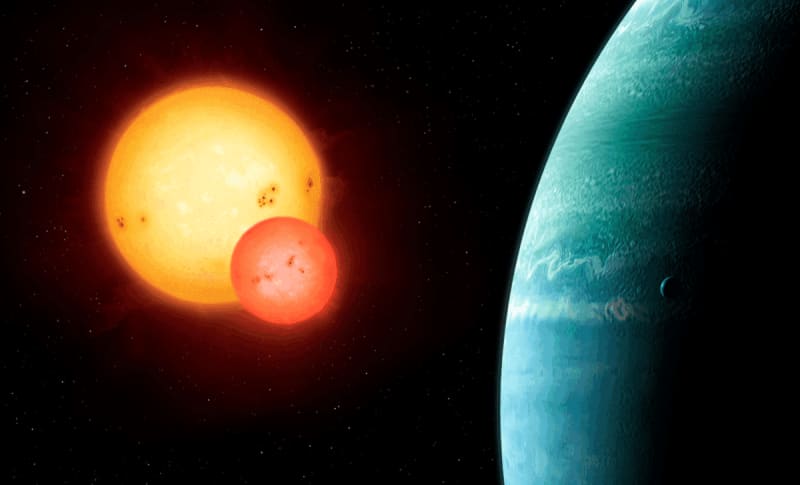
Image credit: Canva | The Daily Galaxy –Great Discoveries Channel
Tiny life forms adrift in alien skies might one day expose themselves through the faintest play of light. A new study suggests that airborne microbes could leave detectable spectral fingerprints in the atmospheres of distant worlds. Instead of relying solely on surface observations, researchers are now turning to the air itself as a potential reservoir of biosignatures. The idea could redefine how astronomers search for signs of life beyond Earth.
The Hidden Signatures In The Skies
A research team has proposed a fascinating new pathway for [biosignature detection:](https://dailygalaxy.com/202…

Image credit: Canva | The Daily Galaxy –Great Discoveries Channel
Tiny life forms adrift in alien skies might one day expose themselves through the faintest play of light. A new study suggests that airborne microbes could leave detectable spectral fingerprints in the atmospheres of distant worlds. Instead of relying solely on surface observations, researchers are now turning to the air itself as a potential reservoir of biosignatures. The idea could redefine how astronomers search for signs of life beyond Earth.
The Hidden Signatures In The Skies
A research team has proposed a fascinating new pathway for biosignature detection: identifying microbial spectral features in planetary atmospheres. The manuscript, **recently submitted in **Arxiv, explores how light scattering and absorption by microbial aerosols could leave distinct spectral imprints observable by telescopes. These airborne microorganisms, if present in a planet’s upper atmosphere, might produce specific reflectance and transmission patterns detectable even from light-years away.
The researchers modeled various microbial populations, comparing their optical behaviors under different atmospheric compositions. Their findings indicate that pigments such as chlorophyll, bacteriorhodopsin, and other microbial biomolecules could generate recognizable absorption bands in the visible and near-infrared ranges. These patterns differ from those of minerals or photochemical hazes, making them potential biosignature candidates. By studying such optical fingerprints, astronomers could gain indirect evidence of biological activity without requiring a direct view of a planet’s surface.
The implications are immense. While current exoplanet surveys mainly focus on gases like oxygen, methane, or ozone, this study opens a complementary line of detection — one rooted in the physical presence of life-bearing aerosols themselves. If confirmed observationally, this method might help detect life on worlds with opaque atmospheres, such as Venus, Titan, or even Earth-like exoplanets cloaked in cloud layers.
Rethinking The Search For Life Beyond The Surface
The manuscrpt, recently submitted in Arxiv, challenges the long-standing notion that life must be found on planetary surfaces or within oceans. Instead, it proposes that life may thrive — and reveal itself — high above the ground, suspended in atmospheric layers where sunlight, chemistry, and temperature align favorably. On Earth, microorganisms are known to persist in the upper troposphere and stratosphere, demonstrating resilience against radiation, dryness, and cold.
If similar airborne ecosystems exist elsewhere, their spectral features could betray their presence. The research team simulated exoplanet atmospheres with variable cloud decks, microbial densities, and particle sizes, evaluating how each factor affects the resulting spectral reflectance curves. These simulations suggest that even sparse microbial populations could leave measurable effects, provided that future observatories — such as LUVOIR, HabEx, or JWST’s successors — achieve sufficient sensitivity.
What makes this approach particularly promising is its flexibility. Instead of searching for a narrow chemical combination (like oxygen and methane), it expands the scope to detect any particulate biosignature that interacts with light in a measurable way. This could accelerate the identification of habitable worlds and refine the prioritization of exoplanet targets for follow-up observations.
Toward A New Generation Of Planetary Biosignature Models
The authors emphasize that understanding airborne biosignatures requires both astrophysical modeling and microbial spectroscopy. Laboratory experiments on Earth are helping refine the reference databases used to identify biological pigments in reflected light. As these databases grow, astronomers will be better equipped to recognize authentic biological signals and distinguish them from abiotic look-alikes.
Future missions could combine remote sensing and in situ sampling to validate these concepts within our Solar System. For instance, Venus’s cloud layers — long suspected to harbor microbial life — represent an immediate testing ground. The upcoming DAVINCI and VERITAS missions could provide data on the planet’s aerosols and their optical properties, paving the way for comparative spectral analysis.
Ultimately, the study urges the scientific community to broaden the definition of habitability. Life may not always dwell on solid ground; sometimes, it may drift in sunlight, carried by planetary winds, leaving traces of its existence written in light.
Enjoyed this article? Subscribe to our free newsletter for engaging stories, exclusive content, and the latest news.